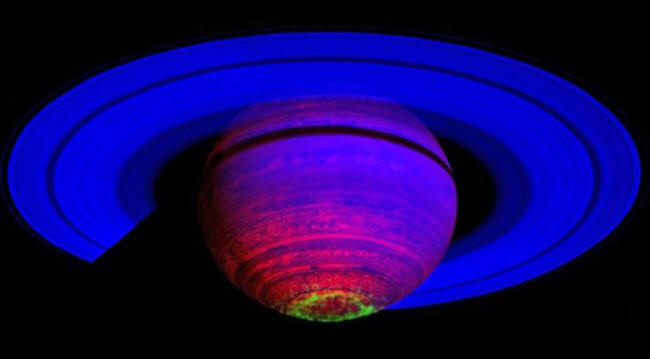|

by Jake Anderson
September
01, 2019
from
TheMindUnleashed Website

The heart
of Saturn
may be far
stranger
than imagined...
The makeup of Saturn, whose billowing storm-like atmosphere
fascinates scientists, has always been a huge mystery.
What comprises the
interior of Saturn, for example, underneath the vast, smoggy 1800
km/hour winds? New analysis of data from the 2017 Cassini probe
suggests the heart of Saturn may be far stranger than imagined.
Our knowledge of Saturn previously
consisted of studying how different wavelengths of sunlight flow
through its atmosphere.
The gas giant is
dramatically different than Earth, consisting of mostly hydrogen and
helium with trace amounts of,
Much further down Saturn
was believed to have a solid metallic core wrapped in layers of
rock, liquid metallic hydrogen, and liquid hydrogen.
The other layers have
remained a mystery.
The Cassini spacecraft studied the solar system for almost two
decades before scientists decided to guide it into a controlled
crash (the intention being to protect Saturn's potentially
life-harboring moons from Earth-born microbial contaminants) into
the atmosphere of Saturn, a
death-plunge that was expected to
produce a first-ever glimpse beneath the arcane atmosphere.
The glimpse was not photographic but telemetric, involving
measurements of the planet's gravitational field and jet streams.
In a new study (Magnetic
Eddy Viscosity of mean Shear Flows in two-dimensional
Magnetohydrodynamics) published in Physical Review
Fluids, a team of researchers says the data sent back from
Cassini may provide strong clues to the nature of Saturn's interior.
"Deep into Saturn,
where the pressure is high, the gas becomes a liquid that
conducts electricity and is more strongly influenced by the
planet's magnetic field," read a press release from researcher
Navid Constantinou.
"An electrically
conducting, flowing liquid will bend or distort a magnetic
field. We showed that the distortion of the magnetic field makes
the fluid more viscous, like honey."
While it's hard to
imagine this honey-like field of magnetically-warped,
electricity-conducting viscosity, scientists say it could answer the
mystery as to why the violent jet streams of Saturn abruptly stop
8,500 kilometers (5,281 miles) inside the planet.
"The mysteries of
what goes on inside Saturn and the other gas giants in our Solar
System are now slowly starting to be unveiled," Constantinou
continued.
"Our findings provide
a promising way for interpreting the data from planetary
missions and offer a better understanding of the planets in our
Solar System and beyond."
|


